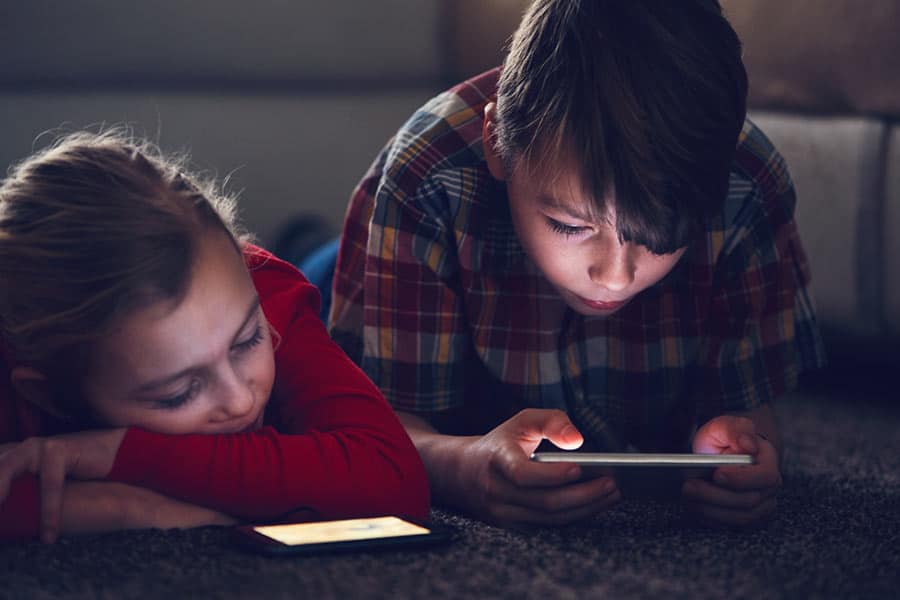Last week I was invited to speak on the TVNZ Breakfast show in response to a controversial statement made by a UK based sociologist Ellis Cashmore. Ellis Cahsmore’s upcoming book “Screen Society” challenges the common train of thought that screen exposure is damaging for our children. Instead, he warns parents against banning the internet at home, claiming it’s “tantamount to child abuse”.
You can see the interview here:
As I said on the show, this statement is controversial but it acts as a conversation starter for a much-needed discussion about constructive technology-based experiences and routines for our kids.
There is no doubt we are in the midst of a technological revolution and we need to be thinking about how we prepare our children for their digital future.
There are definite social – and educational – advantages to the internet and also screen time. The internet has exposed many areas of life previously unknown; opening opinions, dialogue and discourse about human rights and progressing civil liberties. All of which are exciting and necessary landscapes for our children to be exposed to.
A complete ban on screen time is incredibly unrealistic. But, screen time also has its own consequences.
The downside:
The truth is that there is no clear information because technology, and our interaction with it, is moving much faster than we can research. Society itself is moving at a faster pace than any other period in our human evolution and we are – to some extent – playing catch up.
However, there are some health and social risks associated with technology. We do know there is a link between increased screen time and childhood obesity and type two diabetes.
From a neurological standpoint there is also a potential difference in brain chemistry due to higher levels of dopamine being released while using screens during critical brain development periods. Our current understanding of this risk is limited. But erring on the side of caution is safest practise.
With regards to social skills and children, there is research highlighting the impact of excessive screen time on attention span and the ability to read nonverbal cues and nuances in face-to-face social interactions. These are critical skills for children to develop to get what they need from their ever-changing environment; connection, attachment and attention.
Additionally, children’s language development, specifically their expressive language development is significantly impacted by increased exposure to screen time.
So. Do I advocate for a totally tech free childhood?
No. A totally tech free childhood comes at a cost too. A child may not be unhappy with what they don’t know they are missing out on. But they won’t necessarily learn the skills the current environment expects from them including digital literacy. I’m reminded of the M N Shyamalan’s movie “The Village” where villagers are happy in their little “safe” bubble, but are totally unprepared for real life.
The lure of screens…
In order to weigh up the pros and cons of screen time, it also helps to understand why we are drawn to screens.
There is a powerful neurotransmitter in our brain called dopamine which is released when we see something novel – it is also involved in our brain’s reward pathways and indicated in addiction.
In truth we spend so much time connected to screens because we find it gratifying and enjoyable. Humans also crave connection as we are social animals. Screens provide instant connection and reward. However, screen use is not the only way in which this should be experienced.
Excessive internet use and screen time could come at the cost of other slower-paced experiences and being present in the moment with others. These are also known to be crucial for our social development, mental health and well being.
So. What can we do?
Mentor rather than Monitor:
It’s not as simple as providing an exact period of time for parents to enforce. Screen use, and our teaching of it as parents isn’t a passive process. We have to actively promote a mindful rather than mindless use of technology. We need to teach our children how to use the internet safely and respectfully of others while also developing the critical skill of self-awareness. If our children are self-aware they are more able to know when something is wrong. This means they are more protected against cyber-bullying or indeed self-monitoring their own screen time use and whether this is to the detriment of other activities and experiences.
It can be helpful to build in trust milestones around their usage which is based on maturity rather than chronological age. Just because a child is of a certain age, does not mean they are ready for different aspects of screen time.
Alongside these strategies, teaching our children how to delay gratification and enjoy the small things in life is important. It’s about giving them a well rounded childhood. For time spent on screens, there should also be time spent playing outside, riding their bikes and being bored so they can develop imaginative play.
With the world becoming more interconnected and instant the internet can perpetuate a sense of increased individualism, so we need to teach our children how make reflective, right and ethical choices not just for themselves but for the good of others. I don’t think it’s hyperbolic to say perhaps the future for a harmonious humanity depends on it!
Modelling appropriate balance in screen time.
It’s maybe an uncomfortable exercise, but reflect on your own screen use and ensure the beep of your device doesn’t cut short your own social interactions. Think how differently you parent when you are distracted! A recent study in 2016 showed that 70% of the kids surveyed felt their parents used social media too much.
If your get tantrums and meltdowns when asking your child to come off their screen, one really helpful strategy is to use the is the:
Build a bridge technique
Next time that they are in the zombie zone sit next to them and engage them in conversation about what they are doing to help their brain to transition from screen world to real world.
So how much screen time for children?
Children aged 2-5 years should have no more than an hour of non-structured leisure-based screen time hour a day.
The American Academy of Paediatrics goes on to recommend that parents of two- to five-year-old children:
- select high-quality programs
- watch videos with their child
- talk with their child while watching videos
- connect what their child sees to their everyday experiences.
Lastly, children aged 5-18 years should have no more than two hours a day. I understand that’s a tough call for teenagers, especially with homework often requiring computer time. But remember that the real issue is non-educational, leisure screen time, so you may want to discount homework screen time.
Parents should be able to decide if these guidelines are too harsh, and allow some screen time flexibility, but not caring at all about the amount of time your children spend in front of screens, especially when we have no clear evidence on the impact -good or bad – could be risky.
We need also to remember like anything else screen time for fun should potentially be seen as a privilege rather than a right. Education is a right, an extra half an hour browsing through YouTube or building a minecraft village is a privilege.
So what does all this mean?
I agree with Ellis Cashmore, that we would question a parent who totally restricted their child’s access to books, toys or interacting with other children, so why totally restrict the internet?
However, as much as the internet provides an amazing learning resource, children also need to have a space to make their own fun and learning using their own imagination. It’s a skill I think children really need, because we live in such a hyper-connected environment. This is especially important regarding the way in which our brain responds to screens and the internet and how this can potentially be at the cost of engagement with other experiences.
Children need time to disconnect and be children and let their little brains catch up with themselves.
The internet and screens are a way of life but so is playing in the mud and climbing trees – and all have a vital part to play in the skills today’s children need for a successful tomorrow.
The key takeaway from this topic is to try and ensure balance, knowing that excessive screen time can come at a cost. There are many ways in which we can connect and learn, the internet and screens are a simply one of these ways, not the only way.
The internet is just a thing, it’s how we use it, or let it use us, that is perhaps most important.





